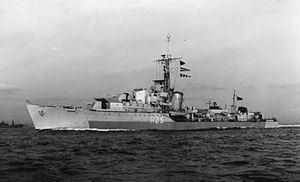HMS Carysfort (R25)

| |
| History | |
|---|---|
| Name | HMS Carysfort |
| Builder | J. Samuel White & Co, Cowes |
| Laid down | 12 May 1943 |
| Launched | 25 July 1944 |
| Commissioned | 10 February 1945 |
| In service | March 1945 |
| Out of service | February 1969 |
| Motto | Manus haec inimica tyrannis : ‘This hand is deadly to tyrants’ |
| Fate | Sold for scrap to BISCO on 23 October 1970 and broken up by J Cashmore. She arrived in tow at the breakers yard in Newport on 15 November 1970. |
| Badge | On a Field Red, out of a ducal coronet gold, an ostrich head Silver in his beak a key Gold. |
| General characteristics | |
| Class and type | Template:Sclass2- destroyer |
| Displacement | |
| Length | 362.75 ft (110.57 m) o/a |
| Beam | 35.75 ft (10.90 m) |
| Draught | 10 ft (3.0 m) |
| Propulsion |
|
| Speed | 36 kn (67 km/h) / 32 kn (59 km/h) full |
| Range |
|
| Complement | 186 (222 as leader) |
| Sensors and processing systems |
|
| Armament |
|
HMS Carysfort was a Template:Sclass2- destroyer of the Royal Navy. She was ordered in 1941, originally under the name HMS Pique.
Her name was changed to conform with the initials "Ca" to her seven sister ships. She is named after John Proby, a politician who was also a Lord of the Admiralty in 1750. In 1752 he was created Baron Carysfort. His son, William Proby, Lord Proby, and his grandson, Granville Proby, 3rd Earl of Carysfort, were both naval officers, the latter eventually became an Admiral. She was the fifth Royal Navy warship to carry the name Carysfort. She was built and engined by J. Samuel White & Co. The keel was to be laid down on 4 May 1943 but was delayed until 12 May 1943 because of German bombing raids. She was launched on 25 July 1944 and completed on 20 February 1945. Her original pennant number was R25 changing to D25 after the Second World War.[1]
Operational service
Following commissioning, Carysfort worked up at Scapa Flow before joining the 6th Destroyer Flotilla of the Home Fleet.[2]
After the war Carysfort was placed in reserve and subsequently modernised, re-entering service in 1956 as part of the 6th Destroyer Squadron. She was recommissioned on 4 March 1958. Both of these commissions were in Home and Mediterranean waters. From 1956 to 1958 R J Trowbridge captained her in the Mediterranean.[3] In 1959 Carysfort was part of the Home Fleet and took part in 'Navy Days' in Portsmouth during that year.[4] She subsequently served in the Far East during the Indonesian Confrontation.
Between November 1962 and May 1964 she underwent a refit at Gibraltar and then joined the 27th Escort Squadron and spent two deployments in the Mediterranean and Far East.[5] In June 1966, Carysfort was ordered to the Seychelles when labour disputes brought the threat of violence. While no intervention by the destroyer was needed in the end, the ship's crew suffered an outbreak of dysentery while at the Seychelles, forcing the temporary introduction of quarantine measures aboard the ship to control the outbreak.[6] Her last deployment was to the Far East between 20 November 1967 and 14 November 1968.
She remained in the Active Fleet until February 1969 when she was placed in Reserve. After being placed on the Disposal List she was sold on 20 October 1970 to BISCO for demolition by J Cashmore. She arrived in tow at the breakers yard in Newport on 15 November that year.[1]
References
- ^ English 2008, p. 120
- ^ Commanding Officers of HMS Carysfort
- ^ Programme, Navy Days Portsmouth 28-30th March 1959, HMSO
- ^ Critchley 1982, p. 92
- ^ "Marines arrive in Seychelles". Navy News. July 1966. p. ii.
Publications
- Colledge, J. J.; Warlow, Ben (2006) [1969]. Ships of the Royal Navy: The Complete Record of all Fighting Ships of the Royal Navy (Rev. ed.). London: Chatham Publishing. ISBN 978-1-86176-281-8.
- Critchley, Mike (1982). British Warships Since 1945: Part 3: Destroyers. Liskeard, UK: Maritime Books. ISBN 0-9506323-9-2.
- English, John (2008). Obdurate to Daring: British Fleet Destroyers 1941–45. Windsor, UK: World Ship Society. ISBN 978-0-9560769-0-8.
External links
- Jim Donaldson's♙Unofficial Site
